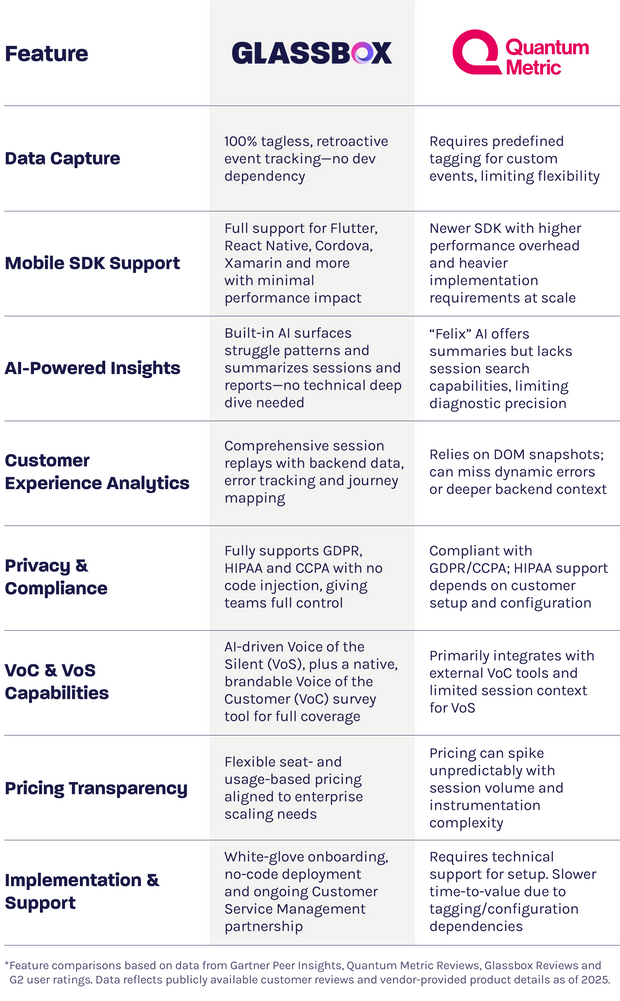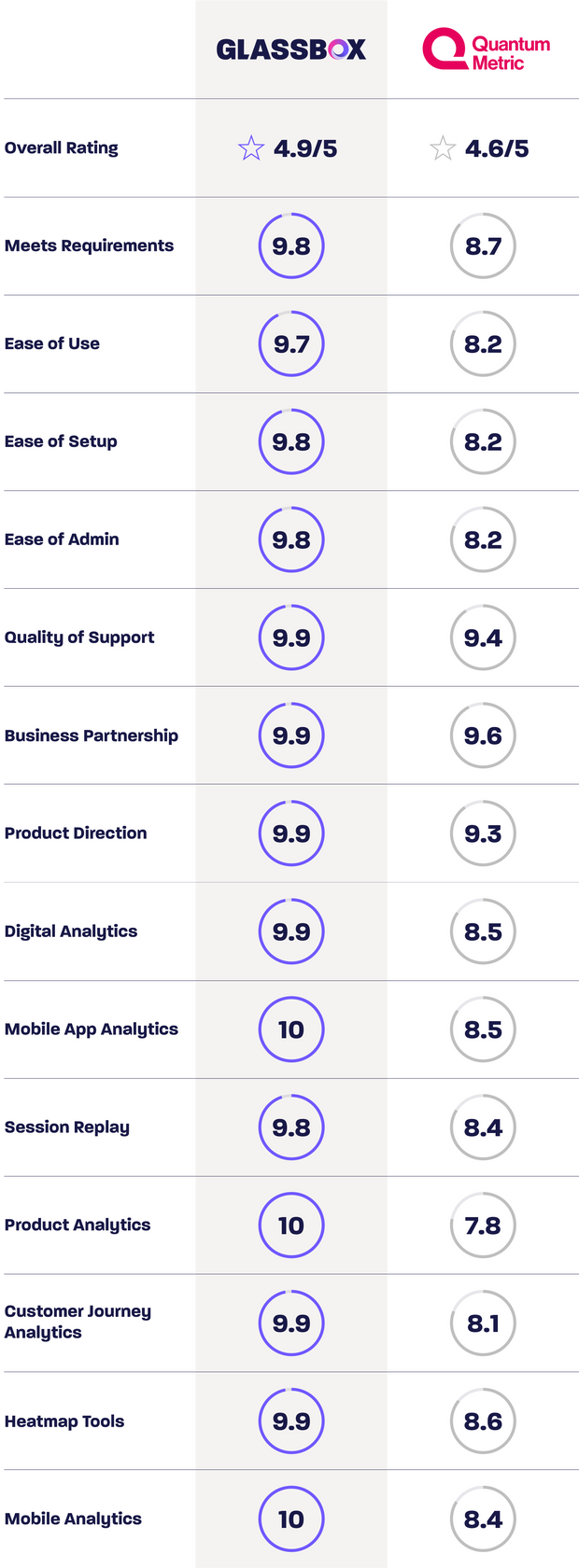Glassbox vs. Quantum Metric: Which Is the Better Choice?



[Updated: July 2025]
Glassbox and Quantum Metric both offer tools to analyze customer behavior, improve product analytics and uncover actionable insights. But when it comes to ease of use, mobile visibility, AI capabilities and long-term scalability, the differences are clear.
While Quantum Metric focuses on engineering-led configuration, Glassbox empowers teams with tagless data capture, seamless mobile software development kit (SDK) support and real-time insight delivery—without the dev cycles or costly delays. For companies interested in enterprise-ready analytics, fast time to value and deeper visibility into the entire digital experience, Glassbox stands out as the leading alternative to Quantum Metric.
Glassbox vs Quantum Metric: Feature Comparison
Evaluating Quantum Metric competitors means looking beyond surface-level features to how well each platform actually supports real-time decision-making, mobile engagement and compliance.
Here’s a side-by-side comparison showing why so many enterprises choose Glassbox as the most powerful alternative to Quantum Metric:*

Why Businesses Choose Glassbox Over Quantum Metric
We analyzed customer reviews across platforms like G2, Gartner Peer Insights and Capterra to understand how teams experience Quantum Metric—and why many are now switching to Glassbox.
While Quantum Metric positions itself as a digital experience platform, growing organizations often encounter friction, especially when it comes to tagging, mobile analytics and real-time insights. That’s where Glassbox stands apart.
Glassbox is the leading Quantum Metric alternative for teams that want to accelerate time-to-insight, reduce dependency on developers and scale their analytics across mobile, web and hybrid platforms—all while maintaining compliance and control.
Here are the five main reasons why teams choose Glassbox over Quantum Metric:
1. Tagless Data Capture
Unlike Quantum Metric, Glassbox was designed from the ground up to eliminate tagging as a bottleneck. Every user interaction—clicks, hovers, scrolls, form inputs, JavaScript errors, Asynchronous JavaScript and XML calls, etc.—is captured automatically, without manual instrumentation.
This tagless architecture unlocks complete visibility from day one. Teams can retroactively ask new questions and analyze past behaviors without triggering a development sprint. It’s an agile, scalable solution for teams that require flexibility.
Quantum Metric advertises tagless capture, but based on customer reviews, it depends heavily on predefined tagging. That means:
Key interactions can go untracked unless manually configured
Retroactive funnel or conversion rate analysis is limited
Engineering must be looped in for updates and coverage gaps
Glassbox not only reduces the burden of tag maintenance, but it ensures teams never miss a moment that matters.
The amount of information provided and the fact that it is all available for us and is tagless. All this makes it very easy to get value. I have been using Glassbox to search for the loading errors and where the core web vitals of pages are not performing properly.”
2. Enterprise-Grade Mobile SDK
Mobile analytics is where many Quantum Metric alternatives fall short. Glassbox isn’t one of them.
Glassbox supports a wide range of native and hybrid frameworks—Flutter, React Native, Cordova, Xamarin and more—while maintaining a lightweight footprint. Teams can monitor gestures, crashes, screen flows, app performance and friction events, such as rage taps, with complete accuracy and minimal impact on UX.
Quantum Metric’s SDK has limited cross-platform support and often requires developer intervention for configuration. For product teams prioritizing mobile customer experience, that’s a roadblock. Glassbox provides the out-of-the-box mobile analytics power needed to optimize journeys at scale.
A retail services customer shared:
Glassbox is a great solution that has been helping us to locate all the places in our mobile app where our customers have a crash or some other issue, which is preventing them from completing their purchase. Generally, every error and issue with our code is captured and can be seen.”
3. Real-Time Journey Analytics
Where Quantum Metric provides general heatmaps and session pathing, Glassbox delivers live, interaction-level journey analytics with no tagging required.
Glassbox tracks and visualizes entire user journeys across devices and sessions in real time, enabling:
Drop-off and abandonment analysis
Funnel tracking with auto-segmentation
Full contextual visibility into each step of the user experience
“Glassbox has a very intuitive interface and this makes it easy for us to visualize complex journeys. Also, the real-time analytics replay is very powerful as we can resolve issues on the fly.”
4. AI-Based Struggle and Error Analysis
Struggle and error detection shouldn’t be reactive. Glassbox’s Struggle & Error Analysis capabilities automatically identify where users get stuck and why, combining behavioral signals, such as rage clicks and dead taps, with technical errors like API failures.
No rule setup. No waiting for batch data. Just fast, actionable insights across funnels, features and flows.
I love the ability to actually watch sessions to see what customers are doing on the app or website. Adobe works in aggregate, but you miss the insights for WHY the customer is dropping off. Seeing them struggle on certain features or designs lets us focus on the right thing.”
While Quantum Metric surfaces issues post-session, identifying root causes often requires manual investigation across dashboards, filters, and replays. In contrast, Glassbox provides product, UX and engineering teams with a shared, real-time view of user frustration, which empowers faster fixes and better outcomes.
5. Data Privacy and Enterprise Compliance
Glassbox was built with enterprise compliance in mind. From automatic PII masking to access controls and audit logs, every layer of the platform reflects a privacy-by-design philosophy.
Glassbox supports GDPR, HIPAA, CCPA and other frameworks across the United States and global markets. This makes it ideal for financial services, healthcare and other regulated industries.
While Quantum Metric offers compliance capabilities and supports GDPR and CCPA, its governance controls may require more manual configuration. HIPAA compliance is not guaranteed out of the box and depends on customer setup. Additionally, JavaScript-based data collection can introduce complexity for organizations with strict privacy requirements.
For enterprises that prioritize data control and compliance without sacrificing usability, Glassbox delivers peace of mind with every session captured.
Love the application as it allows real-time visibility of actions taken on the system. This helps for coaching and understanding for investigation. This also improves performance. The application itself is very easy and simple to use. Glassbox is used for daily monitoring to prevent data breaches as well. It also breaks it down in a timeline.”
Customer Ratings
As part of our analysis, we combed through as many verified customer reviews as we could find. Here's how Glassbox and Fullstory compare on G2, which contains over 1,000 reviews across both platforms.

How Glassbox and Quantum Metric Compare on Core Capabilities
When evaluating Quantum Metric competitors, it’s important to go beyond surface-level comparisons and assess how each platform performs in real-world enterprise environments. From session replay depth to mobile SDK maturity, Glassbox delivers superior performance across the board, with features like:
Session Replay and Event Capturing
Glassbox captures both the visual front-end and the technical backend of every session using server-side recording. This dual-layer visibility makes it easier to pinpoint root causes of friction, whether it’s a JavaScript error, API timeout or abandoned checkout.
By contrast, Quantum Metric relies on client-side DOM snapshots, which can miss dynamic content or fail to capture granular error tracking events, especially in single-page applications (SPAs) or hybrid apps. Product teams using Quantum Metric may face delays in accessing actionable insights because they need to configure and tag events manually before analysis.
With Glassbox, there’s no such lag. Teams can apply retroactive filters, isolate problem sessions and optimize conversion funnels instantly, all without extra tagging or engineering cycles.
Mobile Experience Capabilities
Mobile experiences now drive customer expectations, which means product analytics must deliver complete visibility into app behavior. Glassbox does exactly that with one of the most advanced, lightweight mobile SDKs on the market—compatible with Android, iOS, Flutter, React Native and more.
Quantum Metric offers mobile SDK support for key frameworks, though some teams may need additional configuration to align tracking and reporting across complex app environments.
Glassbox captures it all—swipes, taps, pinches, errors—and maps screen flows across digital experience touchpoints, giving mobile teams the visibility they need without compromising performance
Heatmaps and Behavioral Visualization
Glassbox offers interactive heatmaps out of the box, including rage, scroll, hover, exposure and click maps. These visualizations adapt in real time to changes in layout or content, making them ideal for digital analytics across SPAs and responsive designs.
With Quantum Metric, users have cited configuration complexity and limited support for real-time behavioral overlays, slowing down AB testing cycles and time-to-insight.
Glassbox enables point-in-time filtering, critical for customer journey optimization, so teams can isolate behavior based on session attributes, customer segments or device type. It also supports A/B testing analysis by allowing teams to filter heatmaps by test variant—whether you're testing different CTAs, color schemes or layouts—so you can see how each version is performing in the wild.
Voice of the Silent vs. Voice of the Customer
Customer surveys, aka VoC, can be helpful, but they only capture the views of a small, vocal minority. Glassbox goes further with VoS, an AI-powered solution that goes beyond traditional VoC and tells you how many other users had a nearly identical experience but did not leave feedback.
Glassbox also includes a native VoC survey collection tool, customizable to your brand, so you can collect, analyze and act on user sentiment in a single platform without relying on third-party survey software.
Quantum Metric supports VoC through third-party integrations, but its AI tools currently focus primarily on summarizing individual sessions. Broader session sentiment and behavioral pattern analysis, especially for silent users, require more manual effort or separate tooling.
Glassbox bridges that gap, combining behavioral signals with session context to reveal patterns of silent dissatisfaction that VoC tools miss.
Integrations and Flexibility
Glassbox integrates natively with enterprise tools, including Google Analytics, Adobe Analytics, Salesforce, Tealium, Segment and Optimizely. These prebuilt connections enable teams to enrich customer interactions with business context and without relying on custom engineering or external middleware.
Quantum Metric supports APIs but may require additional configuration or third-party connectors to achieve the same level of interoperability. In regulated industries, this can lead to delays and compliance headaches.
With Glassbox, teams gain a unified, extensible analytics tool that supports both out-of-the-box deployment and long-term flexibility.
Pricing, Support and Deployment
The total cost of ownership and long-term value of a digital experience platform matter just as much as its features. At enterprise scale, pricing flexibility, implementation time and reliable customer support can either accelerate your ROI or create unexpected friction.
Let’s unpack how Glassbox and Quantum Metric differ across these essential categories and why Glassbox is the better fit for teams looking for predictable scaling, faster time to value and a true customer success partner.
Pricing Models
Glassbox offers transparent, enterprise-friendly pricing. There are no hidden fees, no overage traps and no guesswork about future costs.
With Glassbox, you get:
Clear, predictable pricing tied to actual platform usage
Visibility into thresholds and entitlements before you hit limits
Enterprise-grade contracts designed to support long-term growths
If you're scaling, Glassbox gives you the confidence to grow without guesswork..
Implementation Timeline
Glassbox accelerates deployment with a streamlined setup process. Our tagless architecture captures behavioral data automatically without the need for manual setup or re-tagging. Prebuilt integrations with tools like Google Analytics, Adobe Analytics and major customer data platforms (CDPs) enable you to begin generating value on day one.
Launch without lengthy tagging sprints
Get real-time visibility into sessions from day one
Requires minimal developer involvement
Quantum Metric typically needs more engineering to deploy and maintain. Tagging setups, custom configurations and data validation cycles can stretch timelines, especially for teams with limited technical bandwidth.
The result? Slower access to digital experience insights, more dependency on devs and delayed ROI.
Customer Support
Enterprise teams need more than help desk ticketing, they need a strategic partner. That’s why Glassbox delivers white-glove support with:
A dedicated customer success manager
Proactive performance reviews and optimization plans
Real-time escalation paths for urgent issues
Enablement workshops and technical training
According to Gartner Peer Insights, Glassbox consistently outperforms Quantum Metric on ease of integration and deployment, and evaluation and contracting.
Bottom Line
Teams choose Glassbox to reduce friction, improve website performance and unlock more actionable insights across the customer journey.
Whether you're optimizing conversion funnels, running A/B tests or scaling product analytics, Glassbox helps you move faster with less effort, delivering clear pricing, quick setup and deep support.
Which Platform Is Right for You?
Choosing between Quantum Metric competitors ultimately comes down to what your team needs today, and how you want to scale tomorrow. If you're looking for a platform that delivers actionable insights without the tagging overhead, Glassbox is built for you.
Glassbox is ideal for teams that want to:
Capture every user interaction without manual event tracking
Gain full visibility into customer journeys across mobile, web and hybrid environments
Leverage built-in AI to surface issues, analyze behavior and prioritize fixes in real time
Maintain privacy-first governance, with compliance tools tailored to enterprise standards
Quantum Metric may be right for teams with deeper technical resources, predefined use cases and slower iteration cycles. But for organizations that move fast and require real-time clarity, tagless architecture and enterprise-grade mobile analytics, Glassbox offers a more complete, scalable solution.
Still Comparing Quantum Metric Alternatives? See Glassbox in Action
Take the platform tour and see how Glassbox helps the world’s leading digital teams optimize every moment.
